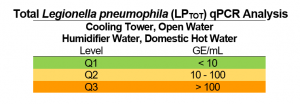Legionella pneumophila qPCR [LQPCR]
Published: September 25th, 2015
Revised: March 3rd, 2023
Quantitative real-time PCR (qPCR) DNA-based method specifically for testing Legionella pneumophila in water samples that has the advantage of much greater sensitivity coupled with the potential to provide results in as little as 24 hrs after submission to the lab.
The method involves DNA extraction and DNA testing by quantitative polymerase chain reaction (qPCR). This method has been extensively validated, and has been used widely in Europe for several years. While this test cannot differentiate between active colonization and residual DNA from dead cells, its strength is as a rapid, highly conservative screen for this important pathogen to guide urgent public health decision-making. When rapid turn-around-time and definitive, accurate detection and precise quantification are required, our Legionella pneumophila quantitative (real-time) PCR DNA-based test is the recommend choice.
When to choose qPCR Legionella pneumophila water test
QPCR rush results can be available within 24 hrs or less. Our regular turn-around-time is typically 48 hrs. Most methods for testing fluids for L. pneumophila rely on culture. Although culture-based methods remain the current gold-standard means of determining the presence of this bacterium, this technique has poor sensitivity (negative results cannot reliably predict the absence of contamination), and they typically require 10-14 days to complete testing. This method has been extensively validated, and has been used widely in Europe for many years; it was approved in 2006 by the French Association of Normalization (AFNOR), a parallel standards body to the Canadian Standards Association (CSA). Since 2012, Public Health Ontario changed to a qPCR test for Legionella for lower respiratory tract specimens.
New guideline values are provided in Public Works and Government Service’s MD 15161 – 2013 ”Control of Legionella in Mechanical Systems Standard for Building Owners, Design Professionals, and Maintenance Personnel, Addendum C”, published in March 2016. These guideline values apply to Normal Operation Mode only, for Emergencies and /or outbreaks of disease, additional assessment and measures are required. As illustrated in the table below test levels are the same for all water sources, however, recommended actions may differ depending of the water source.
Sample collection procedure
- Collect water (a 500 mL bottle with preservative is provided by Sporometrics) in sterile, screw-top bottles. For water sources expected to contain disinfectant chemicals such as chlorine, the collection container should include a suitable preservation buffer (the US-CDC recommends sodium thiosulfate to a final concentration of 0.1 M). Sporometrics provides sample collection containers to meet your needs. Please contact us prior to sampling to make arrangements.
- Collect culture swabs of internal surfaces of faucets, aerators, and shower heads in a sterile, screw-top container (e.g., 50 mL plastic centrifuge tube, with or without preservation buffer, according to the above guidance). Submerge each swab in approximately 5 mL of sample water taken from the same device from which the sample was obtained.
- Transport samples to the laboratory as soon as possible after collection. Samples may be transported at room temperature but must be protected from temperature extremes. Samples not processed with 24 hours of collection must be refrigerated.





